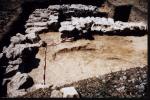Summary (English)
In July 2005 the Museum of Lika in Gospić conducted the first season of excavations at the Čovini-Crikvine site which lasted for 13 days and which was a part of the project of systematic research of the medieval sacral sites at Smiljan village. The site is located on private property at cadastral parcel no. 1575, in the cadastral municipality of Smiljan and has grown into a dense vegetation cover of the maquis type and to a lesser extent in tall trees. Due to the oral tradition of the “old” church, unlike other plots, it is not in agricultural use. The position is located in the centre of the field, on a slightly elevated ridge, not far from the right bank of the Otešica River and the Mandinac Spring. According to the legend, there was a church dedicated to Mary Magdalene, and not far from it a hospice was situated. After clearing the terrain, a 5 × 5-meter trench was opened along the northeast edge of the plot, where the terrain, as it was visible on the surface, was recently excavated. Regardless of the small excavated area, a part of the architectural complex was recorded, probably a church, oriented in the southeast-northwest direction with a shallow semi-circular apse in the southeast, and a southwestern perimeter wall. It is connected to a possible addition and/or extension that yet has to be specified. No fragments of decorative stone have been found, nor have any carved stone been recorded, but several fragments of plaster with characteristic Gothic paintings have been discovered.
A large number of dislocated human skeletal remains were recorded during the excavation, and eight in situ burials were excavated. These are differently oriented burials of adult deceased individuals. Graves 2, 4, 5, 6, and 7 were buried inside the nave and have the same orientation as the church, while graves 3 and 8 were buried in a devastated space between the shoulders of the apse and the church sanctuary secondarily using the walls as a grave architecture. The deceased have different positions of arms – laid on their stomachs, laid or crossed on their chests, and grave goods are rare.
Judging by the layer with burials, it is evident that at least two burials (graves 3 and 8) were made after demolition or certain constructive adaptations of the building, which together with clumsily executed architectural solutions leads to a date earlier than the end of the 13th and 14th centuries, After the campaign, the trench was covered with geotextile and reburied with soil (T. Kolak 2006, Hrvatski arheološki godišnjak 2/2005, 287–288).
- Tatjana Kolak
Director
- Tatjana Kolak
Team
- Helena Nodilo
Research Body
- Muzej Like Gospić
Funding Body
- Grad Gospić
- Ministarstvo kulture Republike Hrvatske






![Download [PDF]](/excavation/skins/fasti/images/results/download_sml.png)
